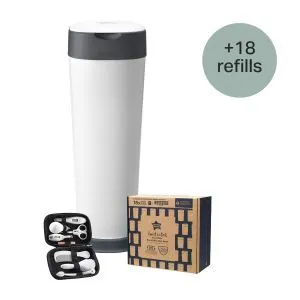
Ultimate XL Nappy Disposal Bundle with 18 Refills
Bundle & Save 40%
Subscription orders can be cancelled at anytime. Free delivery on all subsequent subscription orders. Find out more about subscriptions.
They’re easy and fuss free
Your products are automatically sent to you
You save up to 10% when you sign up for a subscription
You can cancel at any time

Travelling with a baby can be full of memorable firsts – first flight, first beach, first nap in a new place. It’s a chance to make memories, see the world through fresh eyes, and break from routine.
But it also comes with challenges; sleepless nights in unfamiliar surroundings, packing like you’re moving house, and trying to soothe a crying baby mid-flight.
Are you wondering when and how to travel with a baby? We’ve got you. A bit of planning goes a long way, and knowing what to pack, how to manage sleep and feeds on the go, and what to expect at each stage of the journey can help take the stress out of travel and give you the headspace to enjoy it.
If you're wondering, "Is it safe to travel with a baby before vaccinations?", the short answer is, it depends. For newborns who haven’t had their first set of routine immunisations (usually given at 8 weeks in the UK), it’s best to check with your GP or health visitor before booking anything. They’ll help weigh up the risks based on your baby’s health and where you’re going.
Most healthcare professionals recommend that parents wait until their baby is at least 2 to 3 months old before planning any non-essential travel. This gives their immune system time to strengthen.
Short car journeys or local stays are usually easier to manage early on. But if you're planning to fly, keep in mind that some airlines allow babies as young as 2 days old to travel, while others require a minimum of 2 weeks. Always check the airline’s policy and think practically. Has your baby settled into their feeding routine? Are you both sleeping OK and getting enough rest? Do you feel up to it?
Flying with a baby can feel daunting, but with a little planning, it can go surprisingly smoothly. Here’s how to make the journey easier for you both.
Explore the Range
Babies pick up on their parent’s energy. So the more prepared and relaxed you are, the better your baby will cope, too. Expect a few curveballs, roll with them, and remind yourself, you’re doing great.
The flight is just a few hours from what will be a much bigger, beautiful adventure.
Technically, some airlines allow babies to fly from as early as 48 hours old. But most UK health professionals advise waiting until your baby is at least 2 to 8 weeks old before flying, ideally after their first set of immunisations at 8 weeks.
Newborns have developing immune systems, and aeroplanes can be crowded, germ-filled environments. Giving your baby time to build some immunity can help reduce the risk of illness during and after the flight.
Every baby is different, though. If your baby was born prematurely, has any health concerns, or you're planning a long-haul trip, it’s best to speak to your GP or health visitor before booking anything. They’ll help you decide what’s safe based on your baby’s individual needs, not just the airline’s policy.
So, how soon can you fly with a baby? Technically, within days, but after 8 weeks is generally safer and more manageable.
Consistency is key. If you’re travelling, aim to replicate your baby’s usual sleep setup as much as possible. A travel cot or portable bassinet that’s safe and familiar makes all the difference.
Look for:
A familiar sleep sack, blanket, or comforter can help settle them too, just be sure to follow safe sleep guidelines and avoid loose bedding for younger babies.
Yes, travel cots are safe for babies to sleep in, if they meet safety standards and are set up correctly.
Always follow the manufacturer’s instructions and give it a trial run at home so you’re confident about how to use it when you’re away.
Travel cots aren’t designed for long-term, everyday use, so it’s best to save them for short stays or occasional daytime naps. While they’re safe and can be a handy, flexible solution when you’re travelling or staying with family, they don’t offer the same level of support needed for your baby’s ongoing development.
If you do use a travel cot when you’re away from home, make sure that:
Babies sleep best when they’re comfortable, not too hot, not too cold. So, when you’re away:
If you're unsure, feel your baby’s chest or back to check their temperature.
Explore the Range
Babies come with baggage – literally. The trick is to pack smart and light, but thoroughly. Must-haves that parents should pack in their hand luggage include:
Use packing cubes or zip pouches to stay organised and grab things quickly, especially mid-flight or on a motorway services stop.
If you're formula feeding and travelling from the UK, the following guidelines apply:
Click here for more in-depth guidance about travelling from the UK with baby food and baby milk.
Explore the Range
Travelling with a baby takes a bit more prep, but it’s doable.
With the right equipment, a flexible mindset, and a few clever tricks up your sleeve, you’ll be ready for whatever the journey brings.
Stay calm, pack well, plan ahead, trust your instincts, and enjoy the adventure. You’ve got this!